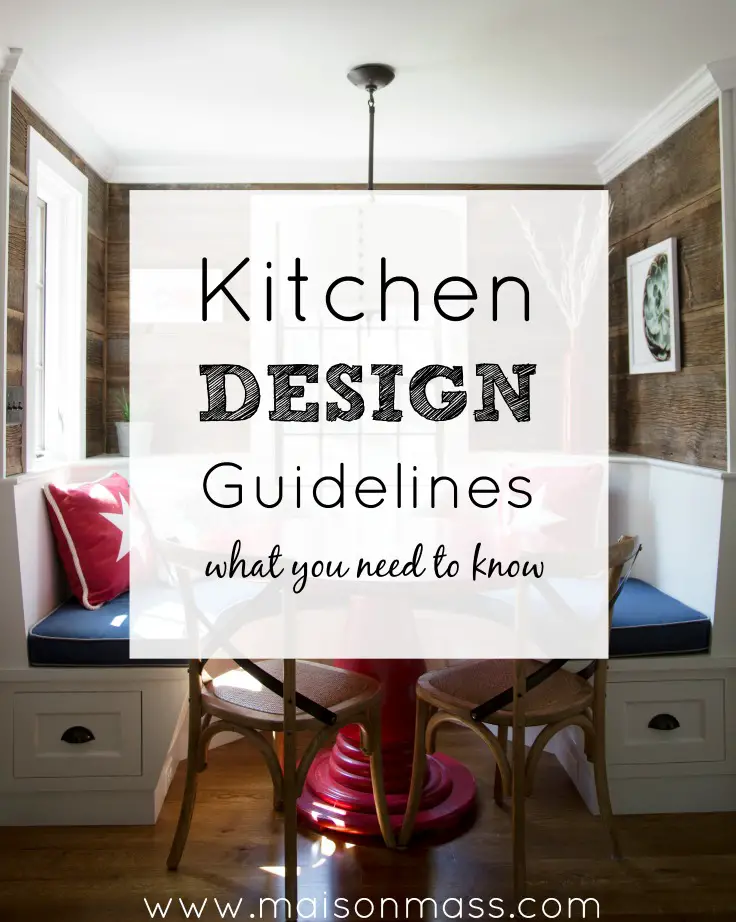This is the third in a series of articles about planning for your kitchen remodel. You can find installment one here and two here. Be sure to check back next week more great advice!
With budgeting behind us, it is time to turn to laying out your space. No matter how large or small your kitchen remodel is or what shape it’s laid out in, there are some universal kitchen design guidelines to keep in mind when you are thinking about where to put your refrigerator or stove in your new space. Some of these rules are dictated by our State Building Code and some are guidelines that were established in 1944 by the University of Illinois and are now sustained by the National Kitchen & Bath Association (NKBA). This list is not exhaustive as some of the 31 rules really delve into the minutiae; but rather the guidelines we think have the biggest impact.
ENTRYWAYS
Kitchen Entry Door – our State Building Code says that interior doors must be a minimum of 30” wide. The NKBA suggests the minimal opening for a doorway into a kitchen should be 32” wide. Universal Design Guidelines call for a 34” door.
Kitchen Door Clearance – the rule is that no entry door should interfere with the operation of any appliance door. Nor should any appliance door interfere with another appliance door. Kind of a no-brainer but may take some finagling if you have multiple entrances or doors (think basement, pantry or laundry room) into your kitchen.
AISLES & LAYOUT
Work Triangle – there are three general work areas in a kitchen: the cooking area including the stove/cooktop, the sink/clean up area and the refrigerator. The general guideline is that these three areas should form a triangle in your kitchen with a minimum of 4 feet between each area and a maximum of 10 feet. Distances are measured from the center of the area (stove/cooktop, sink, refrigerator). This is a guideline and not a steadfast rule as a one wall kitchen would never be able to create a triangle and modern kitchens tend to be much larger with multiple work areas for multiple cooks. Despite that, it remains a good rule of thumb when laying out where the bulk of the activity takes place in the kitchen.
Work Triangle Traffic – no major traffic patterns should cross the work triangle. In our old kitchen, I had been known to yell – get out of the kitchen! Now with our new layout, the walkway through the kitchen allows for safe passage without disturbing the cook!
Work Aisle Width – the width of a work aisle should be at least 42” for one cook and 48” for two cooks. A work aisle is defined as a space where someone would stand to work in the kitchen.
Walkway Width – the width of a walkway in the kitchen should be at least 36”. A walkway is defined as a passageway in the kitchen. In kitchens where the walkway and work aisles are the same, the work aisle guidelines prevail.
SEATING
Traffic Clearance at Seating – In a seating area where no traffic passes behind a seated diner, there should be a minimum of 32 inches of clearance from the counter/table edge to any wall or other obstruction behind the seating area. If traffic passes behind the seated diner, allow at least 36 inches to edge past or at least 44 inches to walk past.
Seating space – Kitchen seating areas should incorporate at least the following clearances: At 30-inch-high tables/counters, allow a 24-inch-wide by 18-inch-deep knee space for each seated diner. At 36-inch-high counters, allow a 24-inch-wide by 15-inch-deep knee space. At 42-inch-high counters, allow a 24-inch-wide by 12-inch-deep knee space. So in general, you should plan for 24” of space across an island or table for each diner and the knee space – the amount of room between the diner and the island or table support in front of them – varies depending on the height of the counter.
APPLIANCE PLACEMENT
Dishwasher Placement: Locate nearest edge of the primary dishwasher within 36 inches of the nearest edge of a sink. Provide at least 21 inches of standing space between the edge of the dishwasher and countertop frontage, appliances and/or cabinets placed at a right angle to the dishwasher.
Microwave Oven Placement: The ideal location for the bottom of the microwave is 3 inches below the principle user’s shoulder but no more than 54 inches above the floor. If the microwave is below the countertop the bottom must be at least 15 inches off the finished floor.
COUNTERTOP GUIDELINES
Cleanup/Prep Sink Landing Area – Include at least a 24-inch-wide landing area to one side of the sink and at least an18-inch-wide landing area on the other side. A landing area is defined as counter space.
Preparation/Work Area: Include a section of continuous countertop at least 36 inches wide and 24 inches deep immediately next to a sink.
Refrigerator Landing Area: Include at least 15 inches of landing area on the handle side of the refrigerator or 15 inches of landing area on either side of a side-by-side refrigerator or 15 inches of landing area no more than 48 inches across from the front of the refrigerator or 15 inches of landing area above or adjacent to any under-counter refrigeration appliance.
Cooking Surface Landing Area: Include a minimum of 12 inches of landing area on one side of a cooking surface and 15 inches on the other side. In an island or peninsula, the countertop should also extended a minimum of 9 inches behind the cooking surface.
Microwave Landing Area: Provide at least a 15-inch landing area above, below or adjacent to the handle side of a microwave.
Oven Landing Area: Include at least a 15-inch landing area next to or above the oven. At least a 15-inch landing area not more than 48 inches across from the oven is acceptable if the appliance does not open into a walkway.
Countertop Space: A total of 158 inches of countertop frontage, 24 inches deep, with at least 15 inches of clearance above, is needed to accommodate all uses.
Of course, if you use a kitchen designer with your remodel, they will incorporate all of these guidelines into your plan – or at least make you aware of them so you can make trade-offs if you need to. Nothing here is absolutely set in stone, they are meant to be thought of as best practices and can of course be broken. We violated at least three of them when remodeling our kitchen several years back. In order to get my coveted island into the existing floor plan of my kitchen, we did not adhere to the work aisle or the dishwasher placement guidelines – when my dishwasher door is open, no one is getting by! Is it difficult for more than one person to work in that one aisle of the kitchen? Yes. Was I willing to sacrifice my island for the extra elbow room? No way.
The bottom line is, understand what the best practices are and then decide what compromises you are willing to make that work for you!
Kristen
For more in our kitchen remodel series:
Gathering Inspiration
Budgeting
Cabinetry
Countertops
Backsplash
Don’t miss the next installment in our Kitchen Remodel series! Subscribe below:














